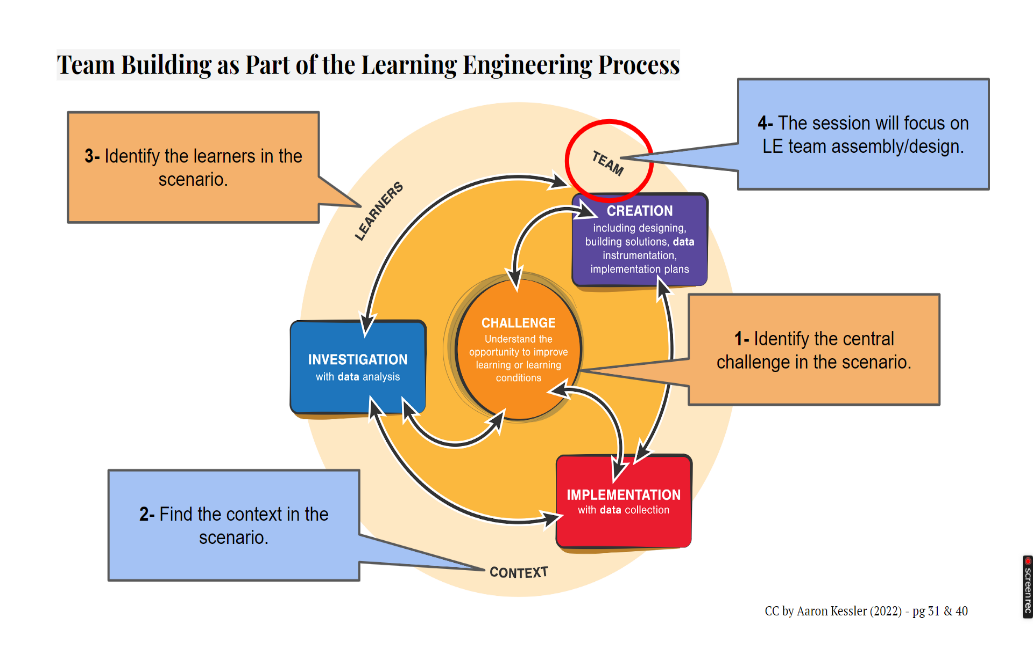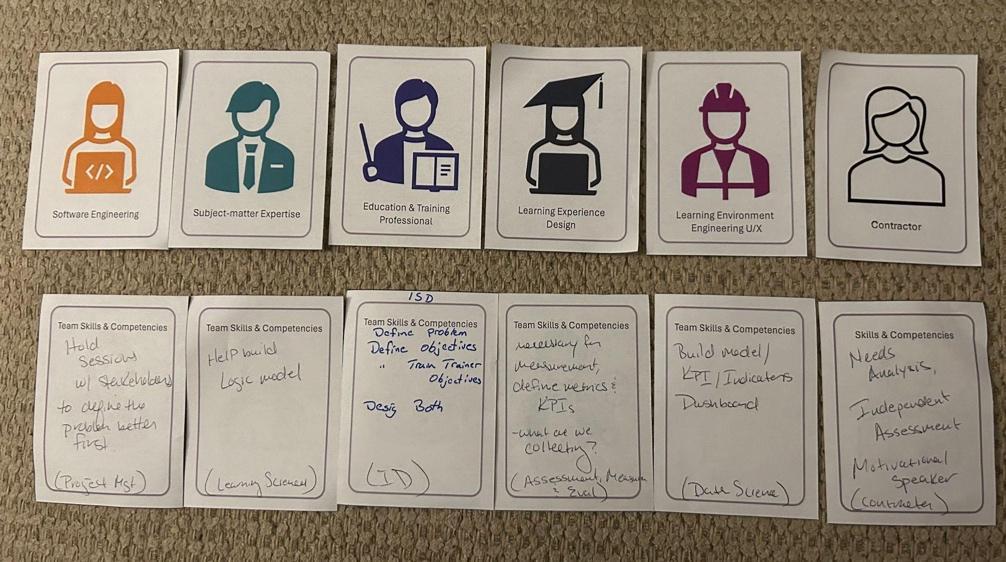 EdTech Archives
International Consortium for Innovation and Collaboration in Learning Engineering (ICICLE) 2024 Conference Proceedings: Solving for Complexity at Scale
EdTech Archives
International Consortium for Innovation and Collaboration in Learning Engineering (ICICLE) 2024 Conference Proceedings: Solving for Complexity at Scale
 EdTech Archives
International Consortium for Innovation and Collaboration in Learning Engineering (ICICLE) 2024 Conference Proceedings: Solving for Complexity at Scale
EdTech Archives
International Consortium for Innovation and Collaboration in Learning Engineering (ICICLE) 2024 Conference Proceedings: Solving for Complexity at Scale
The learning engineering process starts with understanding the challenge within a context, which then goes through cycles of creation, implementation, and investigation, often concurrently (Kessler et al., 2022). The scale of the challenge may range from designing workshops and courses to developing software solutions and learning technologies to building complex global learning systems. Based on the components of the learning engineering process which include human-centered design, data-driven decision-making, engineering principles, and learning sciences, the process in defining and creating a solution involves a multidisciplinary approach (Goodell & Kolodner, 2022).
Areas of expertise to implement the learning engineering process include assessment, evaluation, data science, instructional design, learning sciences, software development, research, systems engineering, relevant subject matter, and others. The collaborative nature of learning engineering is illustrated in Figure 1 using the analogy of a flower where each petal represents a different area of expertise crucial for designing learning solutions. The center of the flower features the "shared understanding" which represents the team's collective vision and alignment on goals (Goodell et al., 2019; Kurzweil & Barry, 2022). The domains on the flower are not conclusive. Other fields and areas of expertise may be needed depending on the challenge, problem, or opportunity.
Figure 1
Learning Engineering Flower

Determining the roles, skills, and distribution of the people to develop the learning solution will depend on the specific challenge (Goodell et al., 2019). The specialists in specific disciplines who come together will have a combination of knowledge and experience to build the solution. They will also have the ability to filter their individual knowledge through the lenses of their combined experience. The strength of these multidisciplinary teams lies in their ability to integrate and understand diverse areas of knowledge, skills, and viewpoints (Kurzweil & Barry, 2022).
Team formation and determining the required solution skillset should continue at every step of the learning engineering process. Since each challenge is different, the work required for each stage of the learning engineering process can also vary. The skills needed, the roles assigned to team members, the contributions for each role, and the overall work can shift depending on the tasks required for the component. (Kurzweil & Barry, 2022).
The "Learning Engineering is a Team Sport: Collaborative Explorations for Team Building Strategies with Short Scenarios in Various Contexts" activity was designed to illustrate and explore the interdisciplinary nature of learning engineering and highlight the need for diverse skills, competencies, and expertise in solving complex educational challenges.
The presenters discussed how to bring together a team to solve real-life problems, envisioning multiple pathways based on the different contexts and scenarios. Participants then engaged in a process shown in Figure 2 to assemble a learning engineering team tailored to a specific challenge. They used the team-building toolkit which contained:
A deck of cards, with each card representing a different role relevant to the learning engineering process.
A predefined scenario that participants used to assemble a team
A scenario analysis checklist
An action plan template
A Google document or shared space where participants documented their decisions, thoughts, and reflections throughout the activity.
Figure 2
Team Building

Participants working in groups selected a scenario for their team assembly. The groups worked through scenarios, using role-playing and team assembly activities to investigate how different skills and competencies could contribute to the effectiveness of the team. The scenarios were developed by each of the ICICLE Market Interest Groups and Special Interest Groups for the workforce, graduate students, pK-12, government and military, and higher education sectors.
The groups began with a deck of cards, with each card representing a different role (e.g., Subject Matter Expert, Data Scientist, UX Designer, Learning Scientist, Software Engineer). Each participant in the group chose a card. Participants reviewed their assigned roles and discussed each role’s contributions. The group analyzed the team’s strengths and weaknesses, assessing whether the selected team composition aligns with the scenario’s needs. If necessary, groups could discard up to two roles and draw new ones, simulating the flexibility of team formation while considering real-world constraints. To further refine their team, participants could add one or two contractor or consultant roles, defining the titles, skills, and competencies to fill any skill gaps. Figure 3 is an example of a group’s cards outlining each role’s responsibility.
Figure 3
Sample Roles listing Strengths and Weaknesses

Once finalized, the group evaluated how effectively their assembled team applied the learning engineering processes to the given scenario and documented their insights. Each group then shared their team roles and strategies in a collaborative discussion, deepening their understanding of the complexities of assembling an effective learning engineering team. Figure 4 is the documentation and reflection of a group’s analysis of their team in a higher education scenario.
Figure 4
Higher Education Scenario Documentation and Reflection
Higher Education Scenario | |
Scenario Description: A small private college must diversify its offerings to appeal to today's students and bring in additional enrollments. They know they must implement new course types, such as certificate programs, competency-based education, and business partnerships. As an initial step to diversify, they partner with a new regional employer to create a cyber security certificate. The company has several job openings but struggles to find local talent in a competitive job market. The company hopes that this new program will create a pipeline of prospective employees with the requisite skills to hit the ground running on company projects. In addition, the company is interested in exploring continuing education and upskilling opportunities for existing employees. Scenario challenge: Create an online program that prepares students from diverse (adult learners) backgrounds to obtain cybersecurity jobs with a local company. The program needs to appeal to these learners, while also assuring them that they will receive requisite skills to get jobs. | |
Document your thoughts on each team member you drew |
|
Document which team role(s) you tossed and which additional roles you drew from the deck |
|
Document the team members’ strengths and weaknesses |
|
Document your final team and share how effective this group will be in applying learning engineering processes to address the scenario you selected |
|
Highlights from the groups’ reflections and key takeaways of the activity:
Role Alignment: The activity helped participants understand how to align team roles with specific learning engineering challenges.
Team Flexibility and Constraint: By allowing participants to toss and replace cards, the activity simulated the flexibility, adaptability, or constraints required when assembling teams.
Scenario-Based Application: The use of scenarios grounded the activity in practical applications, demonstrating the simulated real-world relevance of different roles in the learning engineering process.
Collaboration: While not every team member needs to be an expert in all areas, the conclusion was that they should have sufficient understanding of other disciplines to effectively collaborate with their colleagues.
Upskilling: If the skill was not already on the team, there was discussion on what the potential was for individuals to further develop their skills through formal education, peer-to-peer learning, or workshops.
This approach encouraged participants to actively engage with the learning engineering team-building process and better appreciate the interdisciplinary collaboration necessary for successful learning engineering projects.